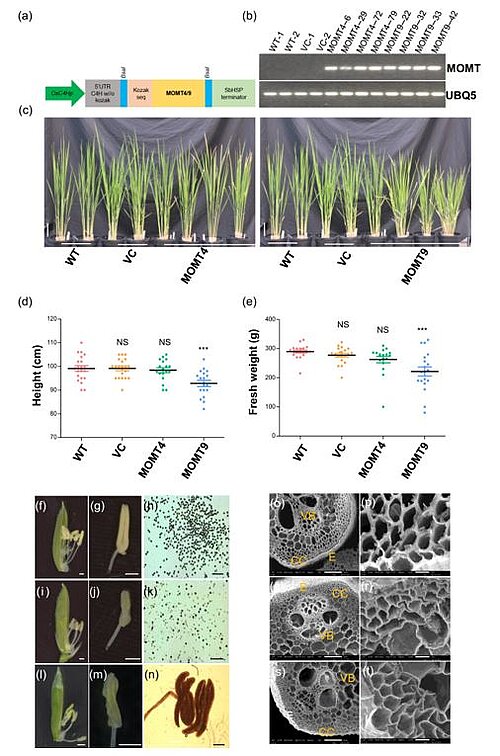Aenert. Research Laboratory news
植物生物质是一种可再生、丰富且环保的能源。利用植物生物质可以减少对化石燃料的依赖,改善环境污染问题。如今,生物柴油、生物氢、生物乙醇、沼气等各种生物燃料与化石燃料并存,并通过不同的生产工艺生产。它们的生产取决于用于原料预处理的酶或酶在合成过程本身中发挥着至关重要的作用。这些酶与原料相互作用的程度对工艺效率和可行性有很大影响。因此,来自可变生物质的生物燃料的商业化具有与生产中涉及的酶相关的某些局限性。
植物生物质含有光合作用产生的富含能量的复杂糖分子。由糖组成的刚性细胞壁围绕植物细胞,以及提供结构支撑的称为木质素的材料。就像提供健康的植物需要木质素一样,如果要利用糖并将其转化为燃料,则需要减少木质素。这一直是旨在利用植物生产燃料和其他通常由石油制成的产品的研究重点。
现在( 2023年),布鲁克海文国家实验室的科学家们已经创造了酶来修饰草类植物,使其生物质含量可以有效地转化为生物燃料和其他生物产品。这些酶可以修饰植物细胞壁中包含的分子,以提供通常锁定在复杂结构中的产生燃料的糖。
近 15 年来,科学家团队一直致力于使用称为单木质醇 4-O-甲基转移酶 (MOMT) 的工程酶来解决这个问题。这些合成酶可以改变木质素的主要组成部分——木质素单体的化学结构。这可以防止它们连接在一起,从而减少植物的木质素含量并使糖更容易获得。
在之前的工作中,科学家们成功在杨树中表达了MOMT。这些酶显示出降低树木木质素含量并增加植物糖释放的强大能力。在最近的研究中,研究了 MOMT 酶在草类植物中的潜在应用。除树木之外的草可以在困难的环境中生长,例如缺乏水或养分的土壤。如果工程植物在这样的环境中生长,这可能会产生优化用于转化为燃料和生物产品的生物质,而这些生物质不必生长在生产粮食作物所需的土地上。
在这项研究中,科学家团队重点研究了两种版本的酶:MOMT4 和 MOMT9,每种都旨在修饰不同的木质素亚基。他们与日本京都大学的研究人员合作,对表达 MOMT4 或 MOMT9 的水稻植株进行了化学分析。研究证明,与未改造的植物相比,改造后的草植物中的木质素含量较少。
然而,尽管 MOMT4 和 MOMT9 是专门设计用于作用于木质素单体的,但测试结果表明这些工程酶也作用于其他成分。这两种 MOMT 都会影响交联酚类物质以及一种名为三辛(tricin)的酚类物质,这是一种仅在草类植物中发现的木质素前体。由于交联酚类和三辛酸的结构发生了变化,MOMT 还减少了这些化合物与细胞壁的结合,从而进一步削弱了它们。还发现改性酚类物质在植物组织的其余部分中积累。此外,具有MOMT9的植物长得不如未改变的植物高,这减少了可获取糖的生物量。这些植物也无法产生种子,这意味着经过改造的植物无法繁殖。为了解决这些问题,未来的研究将集中于控制木质素在植物不同部位如何改变的方法。
Image: Phenotypic analysis of MOMT4 and MOMT9 transgenic plants. (a) Expression cassette of MOMT4/9 under OsC4H promoter with OsC4H 5′ untranslated region, a kozak sequence and a sorghum heat shock protein gene terminator (SbHSP). (b) The RT-PCR analysis of MOMT4/9 transgene expression in the WT, empty VC, MOMT4, or MOMT9 overexpression lines. Rice ubiquitin 5 gene (UBQ5) was used as the control. (c) Morphology of the regenerated 1.5-month-old MOMT4 and MOMT9 overexpression plants in T0 generation after first time cutting. Scale bar = 10 cm. (d and e) The measurements of plant height (d) and aerial biomass yield (e). Data are presented as mean ± s.e. (n = 20). Each data point represents individual MOMT4 or MOMT9 transgenic line. *** Indicates statistically significant difference with P <0.001, compared to the WT (one-way ANOVA test; Tukey's multiple-comparison test). (f–n) Floret and anther morphology, and Iodine-potassium iodide staining of mature pollen grains of the WT (f–h), MOMT4 (i–k), and MOMT9 (l–n) overexpression plants. Scale bar = 500 μm in (f–n). Note that MOMT9 anthers did not release any viable pollen grains (n). (o–t) Scanning electron micrographs of transverse sections of the fourth stem internodes of T0 generation plants after the fourth successive asexual propagation–regeneration, and the enlarged vision of their collenchyma cells of theWT (o, p), MOMT4 (q, r), and MOMT9 (s, t). E, epidermis; CC, collenchyma cells; VB, vascular bundle. Scale bar = 50 μm in (o, q, s) and 5 um in (p, r, t)
Source: Nidhi Dwivedi, Senri Yamamoto, Yunjun Zhao, Guichuan Hou, Forrest Bowling, Yuki Tobimatsu, Chang-Jun Liu/ Simultaneous suppression of lignin, tricin and wall-bound phenolic biosynthesis via the expression of monolignol 4-O-methyltransferases in rice/ Plant Biotechnology Journal, 05 October 2023/ doi.org/10.1111/pbi.14186/ Open Access This is an Open Access article is distributed under the terms of the Creative Commons Attribution-NonCommercial 4.0 International
寻找生物燃料生产的有效方法是一项重要任务如果我们要减轻气候变化的有害影响。2015年,科学家们测试了对木质素单体4-O-甲基转移酶的活性位点进行特异性重塑是否会产生一种能够特异性甲基化缩合愈创木基木质素前体松柏醇的酶。通过将晶体结构信息与组合活性位点饱和诱变相结合,并使用工程化的混杂酶MOMT5(T133L/E165I/F175I/F166W/H169F),他们通过添加四个取代(即M26H、S30R、V33S)来重塑底物结合口袋。 ,和T319M,它创造了一种能够有区别地醚化松柏醇对羟基的突变酶。工程酶变体显着减少了造成空间位阻的底物结合袋。发现所得的酶变体非常适合调节植物中的木质素组成和/或结构。
Image: The scheme of lignin polymerization process and MOMT-catalyzed reaction. A, lignin monomeric precursors. B, MOMT-catalyzed methylation reaction. C, the dehydrogenation of monolignols. D, the subsequent polymerization process
Source: Yuanheng Cai, Mohammad-Wadud Bhuiya, John Shanklin, Chang-Jun Liu/ Engineering a Monolignol 4-O-Methyltransferase with High Selectivity for the Condensed Lignin Precursor Coniferyl Alcohol*/ Plant Biology| Volume 290, ISSUE 44, October 2015/ Open Access This is an Open Access article is distributed under the terms of the Creative Commons Attribution 4.0 International (CC BY 4.0)
2016 年,科学家们表达了一种工程化的 4-O-甲基转移酶,能够化学修饰木质素单体前体的酚部分,从而防止它们掺入木质素聚合物中。这极大地改变了杂交白杨的木质素含量和结构。当进行酶消化和酵母介导的发酵时,来自转基因白杨的木质生物质的单糖释放量增加了 62%,乙醇产量增加了 49%。此外,还发现细胞壁结构的变化不会抑制树木的生长和生物量产生。
Image: (a) Three-month-old hybrid aspens of control (left) and three MOMT4 independent transgenic lines (right). (b,c) Phloroglucinol-HCl staining of the stem cross-sections of control (b) and MOMT4-0 transgenic line (c). (d,e) Mäule staining of the stem cross-sections of control (d) and MOMT4-0 transgenics (e). Scale bars, 1 mm. (f) Acetyl bromide total lignin content in the cell walls of control and MOMT4 transgenic aspen stems. (g) The monomers released by thioacidolysis from the stem cell walls of MOMT4 transgenic aspens; S, syringyl; G, guaiacyl; H, p-hydroxyphenyl; CWR, cell wall residues; Ctrl., control. Data in f,g represent mean±s.e. with three biological replicates (each with three technical repeats) for the control and three technical repeats for the individual transgenic lines. ** Indicates significant difference of lignin content (f) or S-monomer (g) compared to the control with P<0.01 (Student’s t-test)
Source: Yuanheng Cai, Kewei Zhang, Hoon Kim, Guichuan Hou, Xuebin Zhang, Huijun Yang, Huan Feng, Lisa Miller, John Ralph & Chang-Jun Liu/ Enhancing digestibility and ethanol yield of Populus wood via expression of an engineered monolignol 4-O-methyltransferase/ Nature Communications volume 7, Article number: 11989 (2016), 28 June 2016/ doi.org/10.1038/ncomms11989/ Open Access This is an Open Access article is distributed under the terms of the Creative Commons Attribution 4.0 International (CC BY 4.0)
减少木质素含量有几个优点: 细胞中木质素较少与未改变的植物相比,表达 MOMT4 的植物可以多收集 30% 的糖,表达 MOMT9 的植物可以多收集 15% 的糖。通过发酵,可以通过转化生产乙醇等糖类生物燃料。乙醇是一种常见的添加剂,用于降低汽油中的化石燃料含量。
下一步将包括分析他们的 MOMT 酶是否可以优化其他草类植物的糖产量。科学家们希望这种酶可以用于改良高粱和竹子等草类能源作物。他们还相信,这将有助于克服未改性生物质作物产生的一些浪费。
编委会
